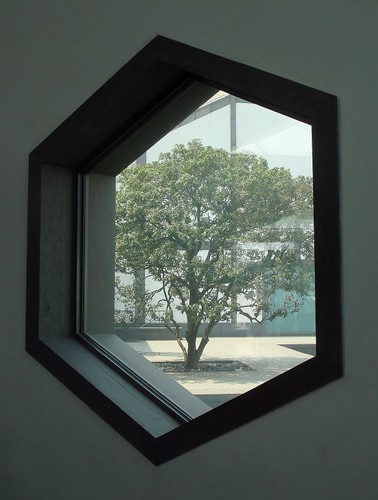2005
Construction on the outside of the building is almost done! In just under 6 months the museum will be ready to be furnished with works of art from around the world and decorated for its visitors. We've finally been able to start work on the gardens and they are turning out beautiful! Everybody has been excited to start on this part of the project and now that work is underway they are proving to be even more fun than expected!
(Photo by Prof. Wang)
(Image from PowerPoint)
The first picture is a photo of the Suzhou Museum, it uses some classical aspects and philosophy of a scholars garden such as the contrast of soft and organic (the tree) juxtaposed with the hard and sturdy figure of the rock. The second picture is an example of those same techniques being used in a centuries old garden in another location in Suzhou. The similarities are clear, and I feel very accomplished in the historical correctness of my designs.
The first picture is a photo of the Suzhou Museum, it uses some classical aspects and philosophy of a scholars garden such as the contrast of soft and organic (the tree) juxtaposed with the hard and sturdy figure of the rock. The second picture is an example of those same techniques being used in a centuries old garden in another location in Suzhou. The similarities are clear, and I feel very accomplished in the historical correctness of my designs.
We are sticking with the traditional aspects of a scholar's garden for this project. There are many of these gardens around Suzhou since, during the Ming dynasty the city has become the height of evolution for these type of gardens. This museum will have a lot of competition in the area for it's garden.
Many of the "scenes" in the gardens reflect traditional Chinese landscape paintings. Ancient scholars put significant effort into designing gardens that directly reference the paintings of the masters.
This picture is a good example of the contrast used in traditional Chinese architecture brought into my modern design. Balence is achieved by using the natural elements of a vibrant green bamboo "forest", immediately adjacent to the wide open spaces, harsh lines and bright white exterior of the museum buildings. Ancient chinese architecture emphasized this type of contrast as a way to balence the natural and the man made and can be seen in many examples of traditional pagodas.
Stark contrast of color (the whites and dark browns in the first painting and the deep reds and light copper in the second) and strict lines against natural lines can be observed in these two examples of Ming dynasty architecture. There is an abundant use of straight lignes and geometric patterns in traditional design which was brought in nicely to my own compostion of the Suzhou museum. I often set up garden scenes in front of tall, white, clearly man made walls with dark detail and straight lines to embrace the concept of balence.
Windows
The windows have been one of my favorite parts of this building. From the begging the windows in the traditional Scholars homes (as seen in many areas around Suzhou) have inspired me to create a "throw back" to the ancient dynasties that so cherished landscape artwork and its meanings. Whilst looking out these windows one should get a sense of being inside a painting. The view should compel you to walk forward into the scene and journey through the gardens. The landscape paintings of the the song dynasties and later expressed this concept through a technique, "shifting perspective". The scholars that broke away from the government during the Ming (1368-1644) and Qing (1644-1911) dynasties tried to recreate this concept in their gardens. Today, in modern Suzhou we are again, recreating these concepts in the Suzhou museum by strategically placing windows to frame the scenes created in the gardens.
(image from Flikr Album)
(Photo by Prof. Wang)
Sticking to tradition these windows were built, understated themselves, to literally frame the out side world and create artworks of their own. The scenes found within a scholars garden mirrored those of highly regarded landscape paintings, and the homes of the Literati class were often built central to expressing the beliefs found with in their art. It is no surprise that these "real life" landscapes became a large part of traditional design.
(Image from PowerPoint)
An image of a window from another beautiful Scholar's garden in Suzhou. Several of the windows in the museum reflect these same concepts, many however display simpler scenes with often less subject matter. I think the "less is more" approach is appropriate given the development of the rest of the structure.Attributed to Li Cheng (919-967 CE)
Wintry Forest, (Northern) Song Dynasty,
Wintry Forest, (Northern) Song Dynasty,
ink on silk, hanging scroll
A landscape painting attributed to one of the most masterful artists of the era, this hanging scrolls exemplifies the scenes attempting to be captured in many of the Scholar's framing windows.
To conclude today's exploration of the inspirations and classical design tools used in the construction of Suzhou's museum I just want to again, remark how strongly this project has connected me to my Chinese roots. Its strange how you can lose sight of your heritage so quickly living in another country and I guess I didn't really realize how much I had forgotten until coming back to China for this project. I'm left mulling over all those philosophies of balance and harmony and connection that my ancestors nearly worshiped and realizing their power in keeping one's self grounded. Heritage and culture is so important and one should routinely revisit their own so as to not lose sight of them. China and Suzhou will continue to be a big part of my life even after the completion of the museum.











No comments:
Post a Comment